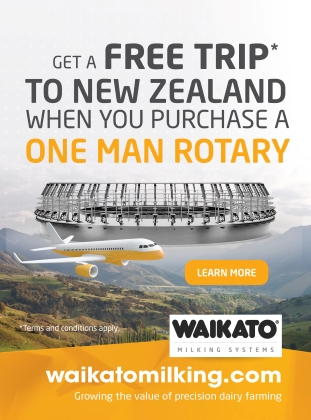Maximizing Robotics on your Dairy

Maximizing Robotics on your Dairy
By Jaclyn Krymowski
Technology has become a staple on the modern dairy. With increasing labor challenges, farms of all sizes have resorted to or embraced the latest tech as a necessity to manage daily operations. But there’s another factor of rising significance – using modern equipment as a tool to gather data that guides productivity decisions.
Beyond simply automating tasks, these technological advancements are revolutionizing how dairy farmers manage their herds and boosting efficiency.
For some operations, it may seem like a pipe dream to afford all of the latest technology with all its luxurious bells and whistles. However, being able to take small steps and incorporate technology slowly can keep the farm viable.
Robotic Parlors – Making the Most of What You’ve Got
One of the biggest takeaways when implementing any new system on a farm should be that these are tools to maximize success – they won’t solve your problems in and of themselves. Sounds obvious, but it is a real pitfall that can happen if you aren’t intentional about mindfully maximizing your investments.
Consider robotic milkers. They can be a great way to boost milk production, improve overall herd health, and reduce labor costs, but they require careful management to fully utilize these benefits. If you don’t learn how to use them, you may just be trading one headache for another.
Cow Comfort and Health – Make sure your cows are comfortable with the robots and that the robots are set up properly to minimize stress and maximize milk let down.
Feeding Strategies – One challenge with moving to robotic systems is the incorporation of grain concentrate into the diet as opposed to the typical total mixed ration. Care needs to be taken to avoid clinical and subclinical acidosis, especially in the early transition period. As well, make sure that good quality hay is continually offered.
Be Mindful with Monitoring and Management
Closely monitor your cows, robotic milking systems and any automation in your feeding process to identify any problems and make adjustments as needed. This includes monitoring animal behavior, system performance, milk production and frequent visits to the milking system interface, especially for fresh and at-risk cows. You want to avoid paranoia, but you also don’t want to be lulled into over confidence that your systems are always doing their jobs.
Many of these ideals can be easily applied to automatic calf feeders. Besides digital monitoring, remember the importance of hands-on maintenance and keeping systems clean and up to date.
As with your parlors, you want to be very mindful of the visits each individual is making and have understandable protocols in place to treat (and when necessary, isolate) flagged animals.
Other Considerations
From manure management to feeding, automation of some sort likely already has a place on your farm. But even if your resources aren’t directly interacting with your animals in an area as important as milking, you will still want to remain vigilant with the tools at your disposal.
A starting point might be to consider what your back up plan is in the event something breaks or lacks power. Do you have service technicians within a reasonable distance? Are your products covered under any warranty and insurance? You should have at least a loose plan of who will be contacted and how the work will be redistributed among the team until you get things back on track.
It’s also a good practice to verify that the software end of your tech – such as in the case of herd health monitors – matches what you are seeing on screen with animals in real life.
Technology on the Farm – Now and Then
The dairy industry has undergone a technological revolution in recent decades, expanding far beyond the traditional confines of the parlor and milkhouse. This transformation has been instrumental in addressing labor shortages and optimizing production efficiency.
The adoption of robotic systems, from automatic take-off milkers to fully automated operations, has been a game-changer. These advanced technologies not only streamline milking processes but also generate invaluable data for precision herd management. By automating routine tasks, dairy farmers can dedicate more time to enhancing animal welfare and implementing strategies to boost milk production through improved genetics, nutrition and overall herd health.
Technological innovation has been a primary driver (arguably the foremost) of the dairy industry’s growth. The ability to collect, analyze and utilize data effectively allows farmers confidently to make informed decisions that lead to increased productivity and efficiency.
Robotic systems have transformed dairy operations by enhancing flexibility, efficiency and data management. Robotic milkers offer cows greater freedom by allowing them to choose when to be milked, usually increasing milking frequency. Automated feed pushers and alleyway scrapers reduce labor, improve cow comfort and contribute to a cleaner environment, which is essential for preventing diseases like mastitis.
The integration of technology extends beyond milking and feeding. Robotic monitoring systems, such as rumination collars, gather crucial data that informs decision-making. By minimizing human error and providing round-the-clock access to information, these technologies empower farmers to optimize herd health and productivity.
The Larger Impact
Technology on the farm has helped the industry make large strides towards smarter farming in our modern day. It helps relieve the burdens of limited labor, minimizes wasted energy resources and can help improve overall animal health and welfare.
Today’s farmers have more flexibility to focus on other aspects of the operation as opposed to strict hands-on labor consuming their days.
The data available provides you with the information needed to make an informed decision. The data and tracking also helps detect issues earlier which can reduce the risks of losing an animal or having to pay more for treatment or reactive actions.
Technology is a powerful tool that can significantly enhance herd management. While it offers valuable insights and automation, it is essential to recognize its limitations. Rather than replacing traditional herd management skills, technology should be viewed as a complement, aiding in informed decision-making. Data collected through technology is a resource that requires interpretation and analysis.




